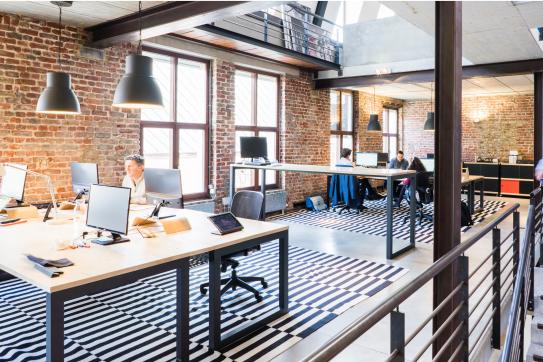Across the globe, many are facing a new normal working from home full time. With makeshift offices popping up in childhood bedrooms, cramped apartments, and suburban backyards, reporting to work has not been business as usual in the wake of the COVID-19 pandemic.
Among those displaced from the office is Jonathan Wasserstrum ’12, the CEO and co-founder of SquareFoot, a commercial real estate firm with listings around the country.
Wasserstrum, who makes it his business to find office space for companies, is optimistic that offices will return to normal once safety is no longer a concern. Below, he weighs in on how companies will manage in the meantime and what the future of work might look like.

Will people be returning to their offices? When?
People are absolutely going to go back to their offices. The offices might look different, but there’s really no doubt in my mind that people will go back. As far as when, it’s not really up to companies, it’s up to the government. We surveyed our team internally and more than a quarter of them said they would go back tomorrow if they were allowed to. And close to three quarters said that they would want to return as soon as it is deemed safe.
Have you already been in touch with businesses that are considering reopening when it’s allowed?
More companies want to get back in the office than don’t. I already have clients who have their executives walking to the offices, by choice, to work socially distanced from one another. For everyone to go back, it’s going to be about having the right safety protocols in place, whether it’s social distancing in the office or elevator protocols or touchless sinks and paper towel dispensers in the bathrooms. It’s also about employees washing their hands, wearing masks, and practicing social distancing – that has been proven to make a drastic difference. If everyone at a company can do those things, there’s no reason we can’t go back in larger groups.
What will change about offices once we can go back?
I think there is a different outlook for tomorrow than there is for a year from now. As long as safety is in question for workers, there will be many precautions that need to be put in place at offices. Once safety is no longer a concern, I think things are going to go back to how they used to be.
For tomorrow, if we go back to work, workplaces will need to have social distancing both in the buildings and within the offices themselves. There cannot be packed elevators on the way up to the office. You might not want 10 people in a conference room at one time. As companies start architecting their back-to-work plans, all of these things have to be taken into account. Safety is extremely important. When safety is no longer in question, I think we will see offices reverting to the norm.
A long-term implication of all this will be a greater receptiveness to remote work. It won’t be an either-or situation. I’ll use myself as an example: my wife is from Westchester and we’re about to have our first kid, so we were already planning on moving to Westchester a year from now.
We still plan on doing that. What has changed, though, is that while I was once planning to commute into the city five days a week, now maybe I will only commute into the office two days per week. From a real estate perspective, this doesn’t mean companies will need any less office space – you will still need desks available to workers even a few days a week.
Will there be a shift away from the open office layouts that have been popularized by tech companies?
Not in the long term. For now, people will be less enthusiastic about open office environments because of safety concerns. Once safety is no longer an issue, those who enjoyed open offices will be eager to go back and those who did not will opt for working remotely. Extroverts tend to prefer the open office layout because they thrive off being around other people – they will be the ones back in the office, while others might continue to work from home.
Have you seen tenants skipping or deferring rent payments to cut costs during the pandemic?
Obviously, no one ever wants to pay rent, pandemic or not, but now companies have a reason. Many tenants are asking their landlords to help them out during this time. We are seeing a lot of landlords offering partial deferrals to tenants. But very few landlords are offering discounts on rent prices, and if there is one, it’s nominal.
Commuting safely is a major concern moving forward, especially in cities where many use public transit. How will this be solved?
I think a couple of short-term changes will need to be made. I think carpooling to the office will become much more common. I think that companies might add outposts in areas where they have multiple employees living – for our company, we have six people who live in Westchester, so maybe for six months we can rent a small office out there and those people can go there to work and drive in their own cars. Within cities, where people might still live two miles from their offices and are too far to walk, they might decide to start biking to work instead of taking public transit. We might also start seeing an uptick in the use of ride sharing apps. So not one person alone in their own Uber, but me and three other people in an Uber – you can roll the windows down and everyone wears a mask. It’s a relatively safe way of commuting compared to the subway. But, with most companies making remote work optional in the next few months, the density on public transit will be reduced should you need to take it.
Will there be a mass movement from the cities to the suburbs?
I think people who were already planning on making those moves will continue to do that, but I don’t think there will be a seismic change in those patterns. The things that draw people to cities are still going to draw people. To use New York City as an example, some people leave the city to get more space and some leave the city for lower rent prices. If everyone goes to the suburbs, that will break down the prices in the city, and those who left unwillingly will come back. I’m not bearish on the future of cities. This is the first – and hopefully last – pandemic I’ve lived through, but if you look back in history at flus that have struck cities, the growth of those cities has continued after the flus are over. After 9/11, people were certain that no one would live or work in the Financial District again. Today, everyone is back. Right now, we are only a couple of months into the shock of this pandemic. Let’s see what happens in a few more months – I know what I would bet on.
